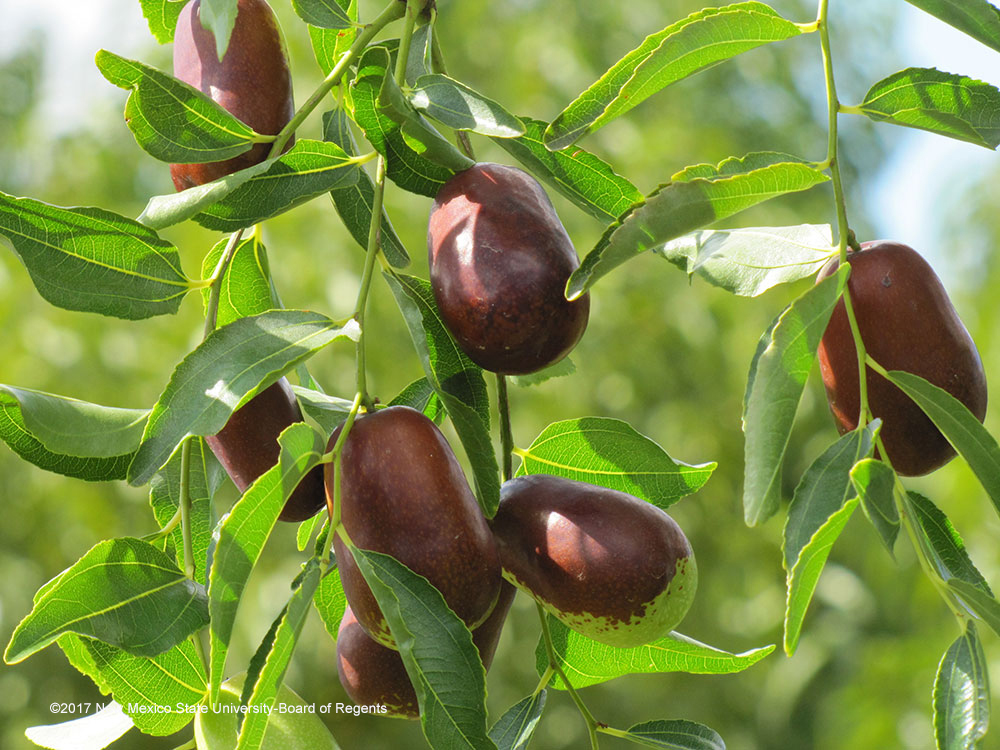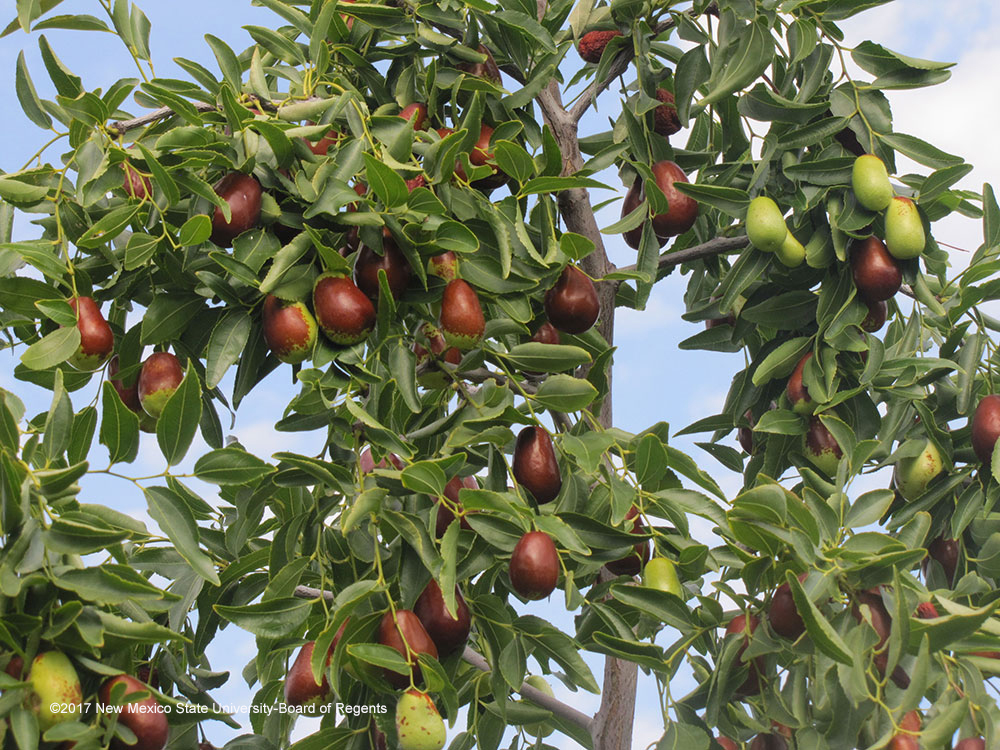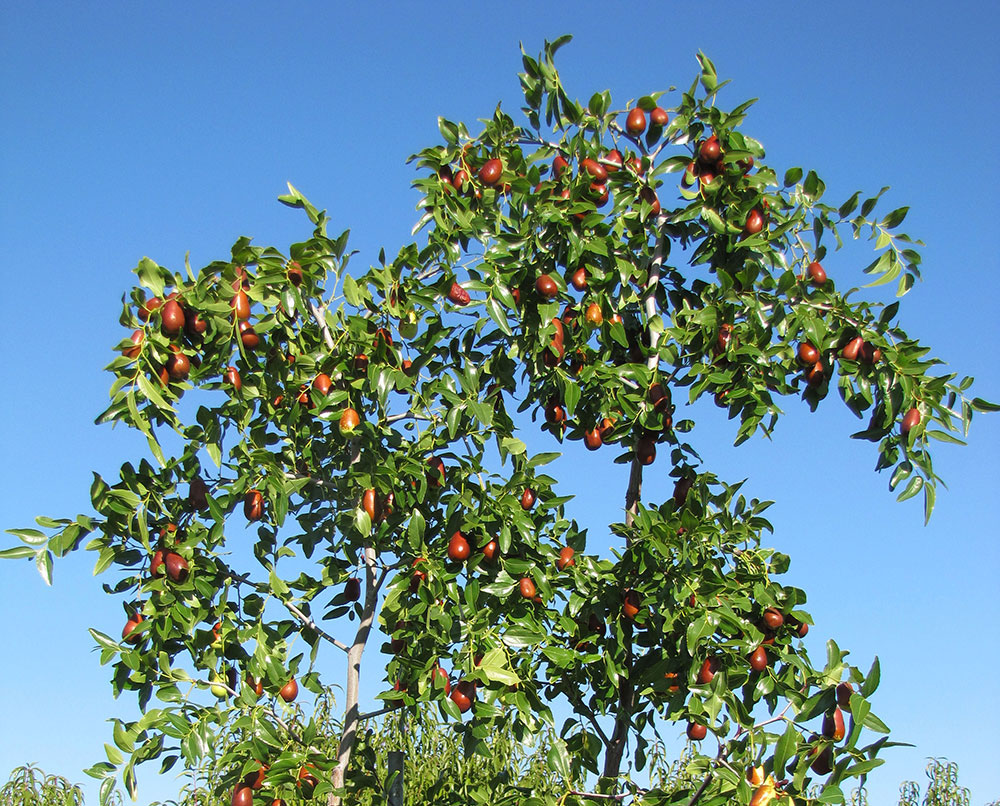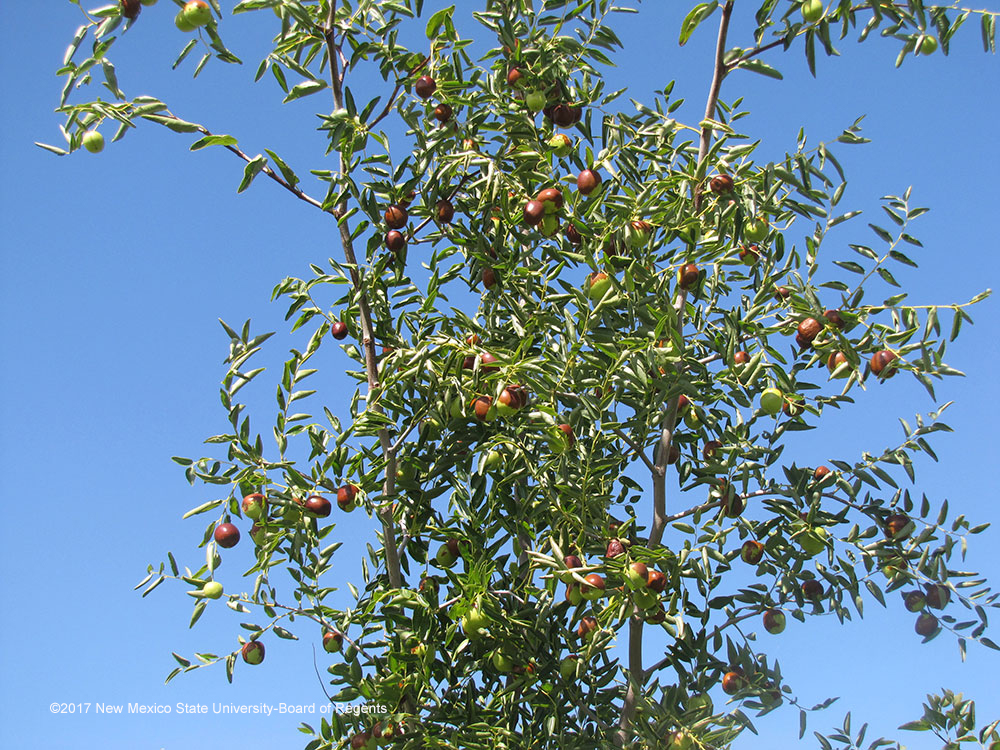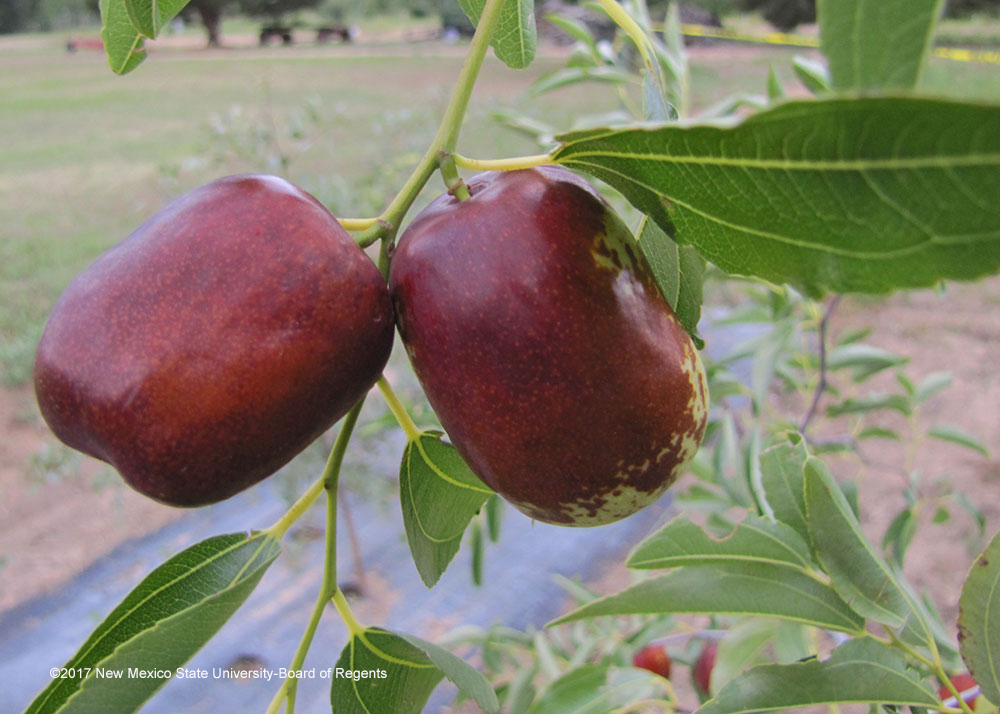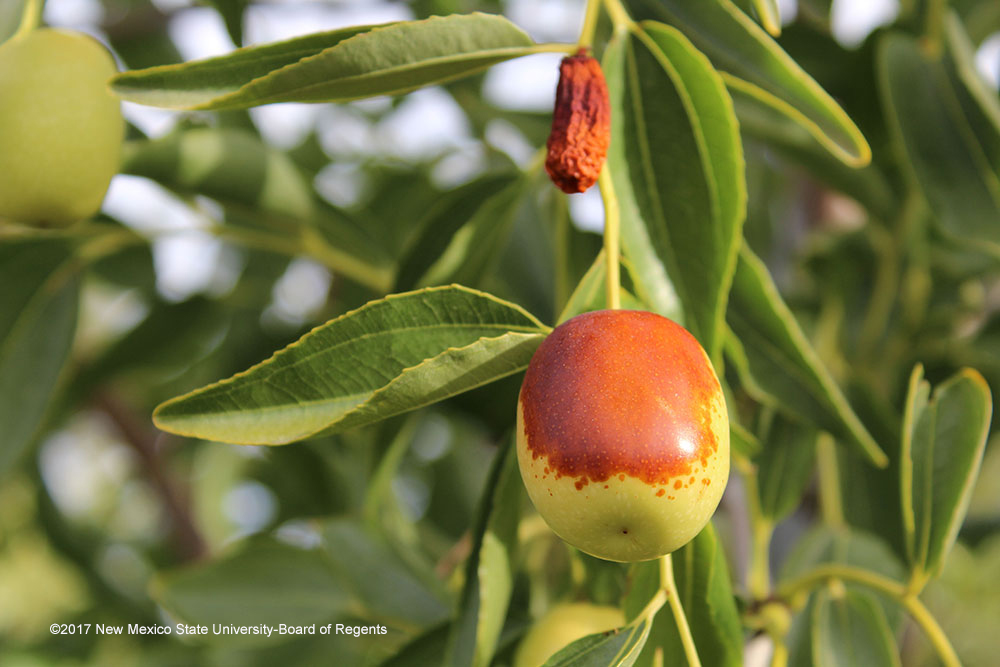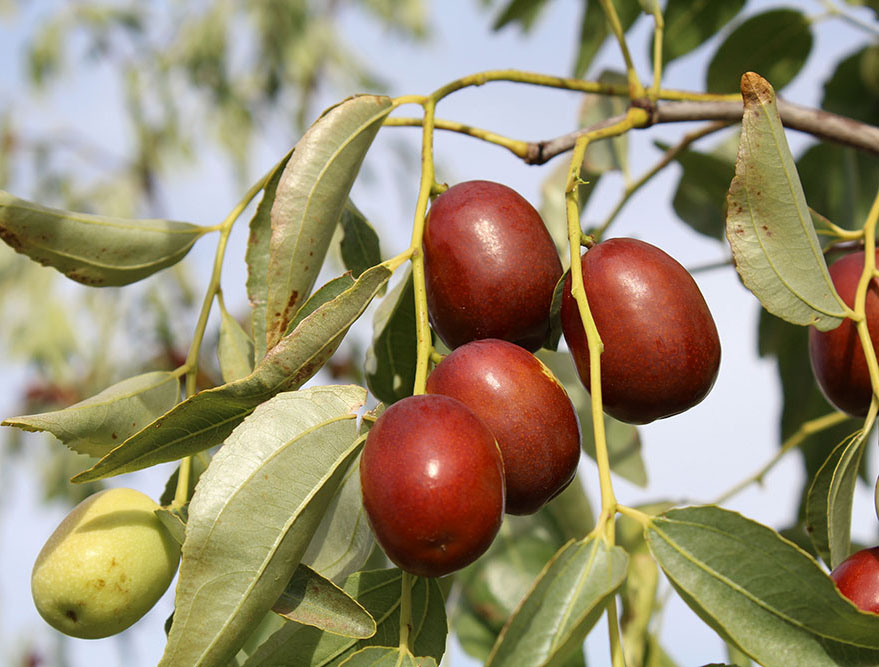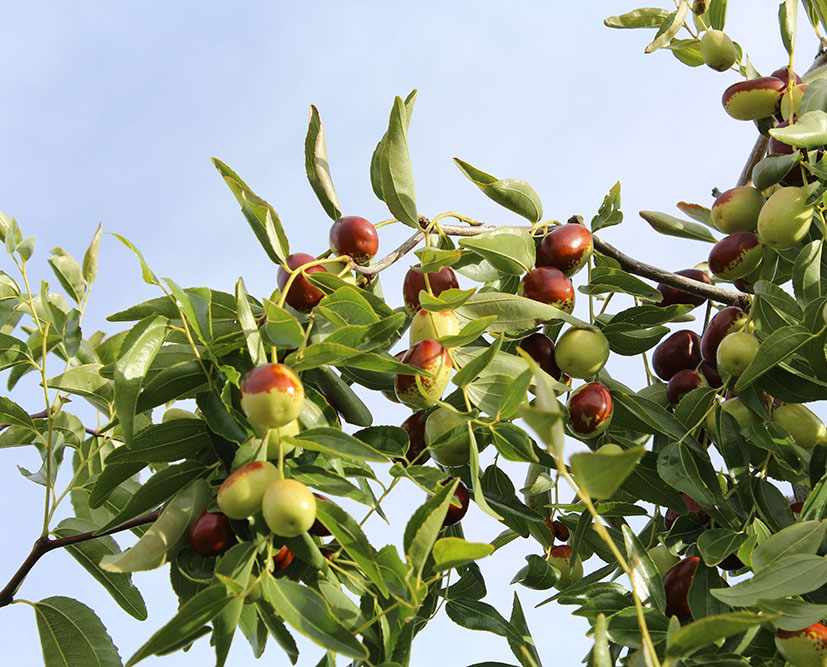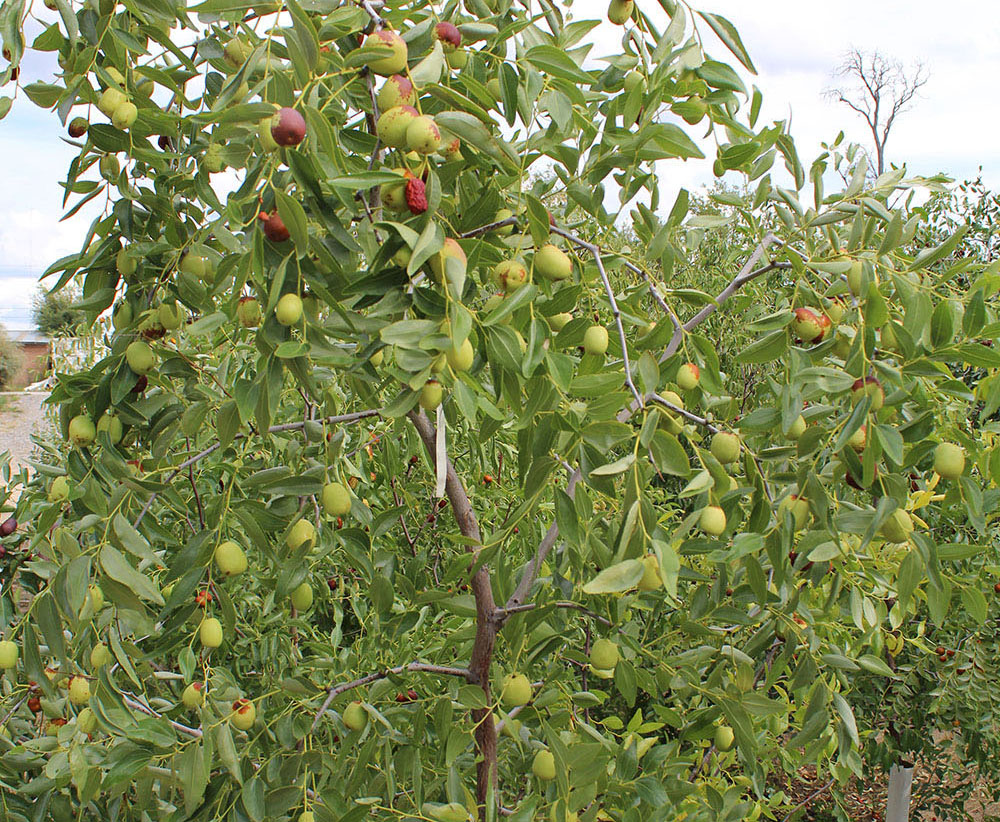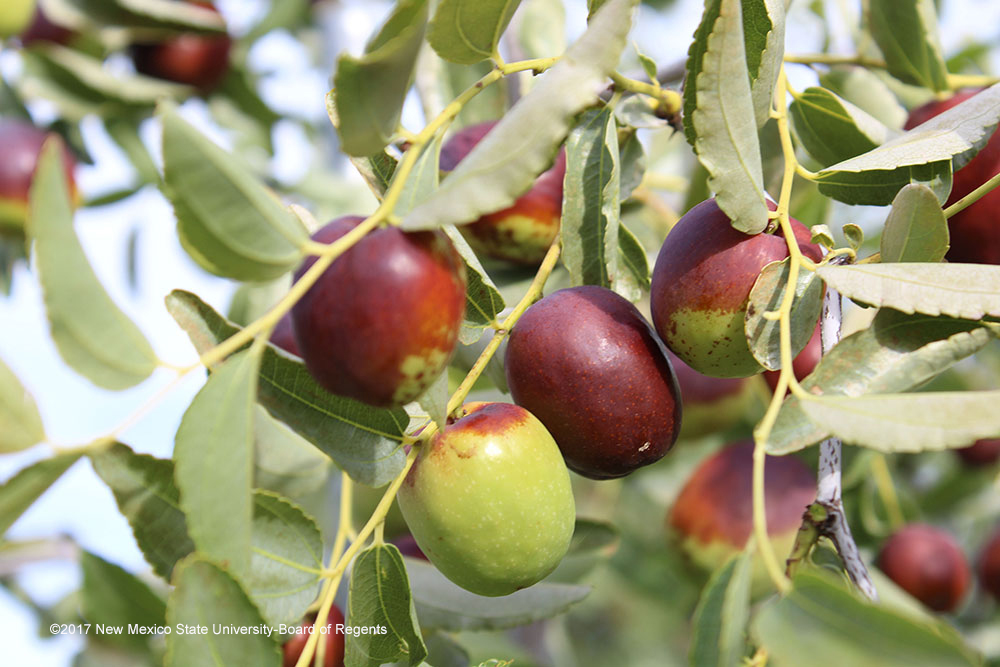For Drying
Click thumbnail images below to see full sized-image.
AmeriZao™ Banzao
©2024 New Mexico State University- Board of Regents
Banzao: (板枣, AMERIZAO™ Banzao):Imported into the US in 2011. Originally from Shanxi Province, China. It is one of the dominant drying cultivars there. High in sugar content, column shaped but flat on one side, medium in size, 9.5-11.0g, 34-38.0_Brix, early-mid season. Fruit drops near maturation.
Don Polenski
©2024 New Mexico State University- Board of Regents
Don Polenski: similar to Lang, and possibly the same as Lang. Excellent drying cultivar.
Globe
©2024 New Mexico State University- Board of Regents
Globe: (‘灵宝大枣’; ‘Lingbaodazao’ ).:Round jujube for drying. Origin: Henan Province, China; imported to U.S. by R. Meyer in 1990s. Fruit: midsize, 25 g, uniform; globose; skin medium-thick, dark red; flesh thick, firm, sweet, with little juice; 23-26_Brix; for drying only, not for fresh use; yield medium; suffers from preharvest fruit drop. Tree: growth habit upright.
AmeriZao™ Huizao
©2024 New Mexico State University- Board of Regents
Huizao: (灰枣, AMERIZAO™ Huizao):Origin: Henan Province, China. Imported into the US by New Mexico State University in 2011. A slow growing cultivar. Medium sized fruit 12.5g in southern NM with 34.8_Brix , mid-season, oblong, good for fresh eating, excellent for drying. Trees were smaller than other cultivars except Dragon. Potential for commercial production.
AmeriZao™ Hupingzao (Jinchang #1)
©2024 New Mexico State University- Board of Regents
Jinchang #1: (Hupingzao, 壶瓶枣, AMERIZAO™ Jinchang): Origin: a selection of Hupingzao in Shanxi Province, China. Imported into the US by New Mexico State University in 2011. Large fruit, avg wt 21.8g with 36.2_ Brix, not uniform size, pear shaped fruit but the diameter differences between two ends were smaller than Lang. Low fruit set, not productive. Jinchang #1, Junzao and Lang had identical DNA sequences in genotyping with SNP markers.
AmeriZao™ Jixin
©2024 New Mexico State University- Board of Regents
Jixin: (‘鸡心枣’ translation “chicken heart”; AMERIZAO™ Jixin):Drying cultivar for commercial production. Origin: Henan Province, China; imported to U.S. 2011 by New Mexico State University. Fruit: midsize, 9.5-10.5 g; elongated/cylindrical, slightly tapered at stylar end; 39.1-41.2 _Brix in central and southern New Mexico; ripens midseason; very good for fresh use, excellent for drying, with shiny skin, fine flavor, and attractive dried fruit. Tree: growth habit upright; yield medium.
AmeriZao™ Junzao
©2024 New Mexico State University- Board of Regents
Junzao: (‘骏枣’, ‘交城骏枣’ ‘Jiaocheng Junzao’; [American] ‘Lang’; AMERIZAO™ Junzao):Original cultivar known as ‘Lang’ for the past century in U.S. Origin: Shanxi Province, China; imported to U.S. through New Mexico State University 2011. ‘Junzao’ and ‘Lang’ had identical DNA sequences in genotyping with SNP markers. See ‘Lang’.
Lang
©2024 New Mexico State University- Board of Regents
Lang: (‘Junzao’; ‘Don Polensky’): Major cultivar in U.S., with medium to large pear-shaped fruit, primarily for fresh use. Origin: China; imported to U.S. 1908, reportedly from Tsintse, Shanxi Province, by F.N. Meyer, USDA, PI 22686; introduced 1924. ‘Lang’ fruit in the U.S. resembles fruit of ‘Junzao’ (‘骏枣’), which is pear-shaped, and not the ‘Lang’ (‘郎枣’) of China, which is cylinder-shaped. See also ‘Don Polensky’, ‘Junzao’, ‘Thornless’, and ‘Xingguang’. Fruit: medium to large, 15.1-18.2 g; pyriform; skin dark red/brown; flavor mild; 29.8-38.4 _Brix for full-red fruit in central and southern New Mexico; suitable for drying, harvest at full-red stage; acceptable for fresh use. Tree: large, upright; mature trees almost spineless; yield medium to high; drying cultivar for commercial production.
AmeriZao™ Xiang
©2024 New Mexico State University- Board of Regents
Xiang (相枣, AMERIZAO™ Xiang):A late maturing drying cultivar, not suitable for fresh eating. Imported into the US in 2011 by New Mexico State University. Ovate shaped with a larger shoulder end, size not uniform. Large fruit 18-19.5g, with 34-38_Brix. Good drying quality, dark color. Productive in southern NM, not suitable for northern NM.
AmeriZao™ Xingguang
©2024 New Mexico State University- Board of Regents
Xingguang: (‘星光’ translation “starlight”; AMERIZAO™ Xingguang): ‘Junzao’ (‘骏枣’) selection reportedly tolerant to witches’ broom disease (Candidatus Phytoplasma ziziphi), selected by Hebei Agricultural University, Hebei Province, China. See ‘Junzao’.
AmeriZao™ Youzao
©2024 New Mexico State University- Board of Regents
Youzao: (AMERIZAO™ Youzao):Origin: Shaanxi Province, China. Imported into the US in 2011 by New Mexico State University. Medium in size, oblong shaped, uniform in size. A very late drying cultivar, high in vitamin C content. Too late for Alcalde area. Not included in the cultivar trials. Limited information.
Thornless
Thornless: ‘Lang’ mutation with fewer spines. Origin: Chico Plant Introduction Station, Chico, CA, by W. Ackerman and Smith. Similar to ‘Lang’, with fewer spines, or virtually spineless. DNA sequence identical with ‘Lang’ in genotyping with SNP markers. See ‘Lang’.
AmeriZao™ Yuanling
©2024 New Mexico State University- Board of Regents
Yuanling: (圆铃枣, AMERIZAO™ Yuanlingzao):Origin: Shandong province, China. Imported into the US by New Mexico State University in 2011. Dominant drying cultivar in the Southwestern Shandong Province in China. Oval shaped, not uniform in size. Excellent drying cultivar, good for drying/processing, not suitable for fresh eating.
